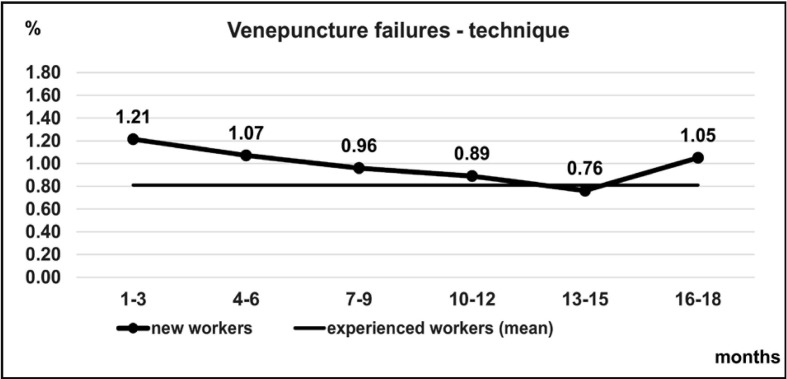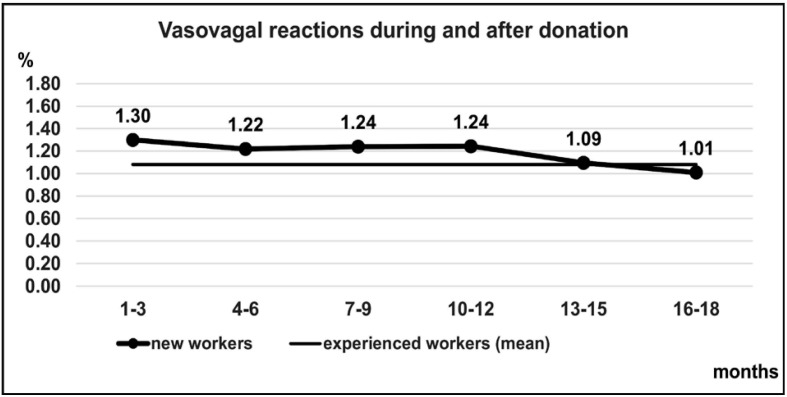Dear Sir,
Blood collection is the first link of the transfusion chain, which is of utmost importance for the quality and safety of transfusion treatment, as well as for donor satisfaction. Venepuncture failures and adverse reactions not only reduce the precious blood supplies available for transfusion treatment, but also discourage future donations1,2. Thus, each blood-collecting establishment should continuously invest efforts to keep the rate of venepuncture failures and donor adverse reactions as low as possible. These goals can be achieved by careful staff education along with ensuring due quality of this segment of the transfusion service. This primarily means monitoring venepuncture failures and donor reactions by using appropriate quality indicators and implementing relevant corrective measures based on the results obtained.
While the frequency of venepuncture failures depends heavily on the skill of the blood collection staff, vasovagal reactions are consequential to an array of haemodynamic and psychological changes occurring in the donor during and after blood donation. It should be appreciated that these reactions are frequently underlain by stress, response to pain, fear and discomfort. The blood collection staff should, therefore, invest efforts to create a pleasant, relaxing environment and to distract the donor’s attention from the unpleasant aspects of blood donation, thus reducing the prevalence of these reactions3.
At the Croatian Institute of Transfusion Medicine (CITM), a quality management system was implemented as early as 1997 and certified in 2001. At the very beginning of its implementation, collection failures were identified as one of the leading types of nonconformities4. At the CITM, collection failures have been defined as failed needle insertion into the vein, and any blood collection interruption due to prolonged duration or other factors related to venepuncture technique (haematoma, poor/absent blood flow) or donor vasovagal reaction. Venepuncture and blood collection successfully performed at a second attempt with the donor’s consent is not classified as collection failure at the CITM. The rate of thus defined collection failures was 1.47% in 1998 and declined continuously to 0.5% in 2001 as a result of proper staff education5. During the 2002–2013 period, the incidence of collection failures varied from 0.52 to 0.92%.
The factors influencing the occurrence of collection failures were analysed on several occasions during the study period and it was found that experience of the staff performing venepuncture was of great importance. Over the years there was a tendency to frequent staff turnover in the blood collection and consequently a variable rate of collection failures. Although staff education that includes acquiring necessary skills has always been perceived as a precondition for quality performance, data on the time needed for newly employed workers to acquire the necessary experience are almost completely lacking. The aspect of adopting communication skills that provide the donor or patient with the feeling of safety and confidence is even less explored3.
In an attempt to determine the time needed for education, training and supervised performance of blood collection, we compared the rate of venepuncture failures (including successful repeat venepunctures) and early vasovagal donor reactions during and after whole blood collection between the procedures performed by experienced (n=3) and less experienced (n=8) staff members. All donation non-conformities known or suspected to be caused by venepuncture technique were considered as “venepuncture failures”. For newly employed workers, the two types of events were monitored during an 18-month period from their starting to perform venepuncture (usually within 15–30 days of their starting to work in the blood collection department) and the incidence of events was compared with that recorded for experienced staff members. In this study, experienced staff members were those with 3 years of experience in blood collection. The mean number of venepuncture failures and donor vasovagal reactions at blood collection performed by these experienced staff members during an 8-month monitoring period served as a reference value. Monitoring of the performance of the experienced staff members began after 3 years of their work in the blood collection department.
The data presented refer to 73,332 donations, comprising 11,061 and 62,271 donations collected by experienced and less experienced staff members, respectively. For experienced staff members, the mean incidence of venepuncture failures during the 8-month monitoring period was 0.81%, while that of early donor vasovagal reactions was 1.08%. The incidence of venepuncture failures and donor reactions at blood collection performed by less experienced workers according to the length of their work experience is shown in Figures 1 and 2. Considering the relatively low frequency of the events observed and a longer period of monitoring, we decided to compare 3-month periods in order to get a statistically relevant pattern and to avoid accidental variations that may result from analysis of short periods.
Figure 1.
Incidence of venepuncture failures due to venepuncture technique at blood collection performed by newly employed workers during an 18-month period.
Figure 2.
Incidence of donor vasovagal reactions at blood collection performed by newly employed workers during an 18-month period.
The difference in proportions test yielded a statistically significant difference in the rate of venepuncture failures between the experienced and less experienced workers in the first two periods analysed (months 1–3, p=0.002; months 4–6 p=0.041). Detailed analysis according to months revealed that the statistical significance between the results of the experienced and less experienced workers disappeared in month 5 of work in the blood collection department (p=0.087). In fact, the incidence of venepuncture failures continued to be higher for the less experienced workers until the end of the first year of work. Statistical analysis did not confirm significant differences in the incidence of donor vasovagal reactions between the experienced and less experienced workers; however, the mean incidences recorded per 3-month period showed that the incidence of donor reactions was higher for inexperienced workers throughout the first year of their work than for the control group of experienced staff. Overall data suggest that the optimal initial education of staff members performing blood collection should last 5–6 months, while taking into account that up to 1 year is needed to acquire desired skill and experience.
A limitation of the present study was the relatively small number of subjects and almost impossible long-term monitoring of their work due to the high turnover of workers engaged in blood collection. It may be useful to conduct similar investigations in other establishments to enable comparison of results with ours. These data are highly relevant for planning and monitoring the education and training of newly employed workers performing blood collection.
Footnotes
The Authors declare no conflicts of interest.
References
- 1.Newman BH, Newman DT, Ahmad R, Roth AJ. The effect of whole blood donor adverse events on blood donor return rates. Transfusion. 2006;46:1374–9. doi: 10.1111/j.1537-2995.2006.00905.x. [DOI] [PubMed] [Google Scholar]
- 2.Eder AF, Notari EP, 4th, Dodd RY. Do reactions after whole blood donation predict syncope on return donation? Transfusion. 2012;52:2570–6. doi: 10.1111/j.1537-2995.2012.03666.x. [DOI] [PubMed] [Google Scholar]
- 3.Stewart KR, France CR, Rader AW, Stewart JC. Phlebotomist interpersonal skill predicts a reduction in reactions among volunteer blood donors. Transfusion. 2006;46:1394–401. doi: 10.1111/j.1537-2995.2006.00908.x. [DOI] [PubMed] [Google Scholar]
- 4.Vuk T. The management of nonconformities in blood establishments. ISBT Science Series. 2011;6:30–4. [Google Scholar]
- 5.Vuk T, Balija M, Jukić I. Quality system in reducing the rate of blood collection nonconformities - CITM experience 1998–2001. Blood Banking and Transfusion Medicine. 2004;2:27–31. [Google Scholar]




